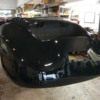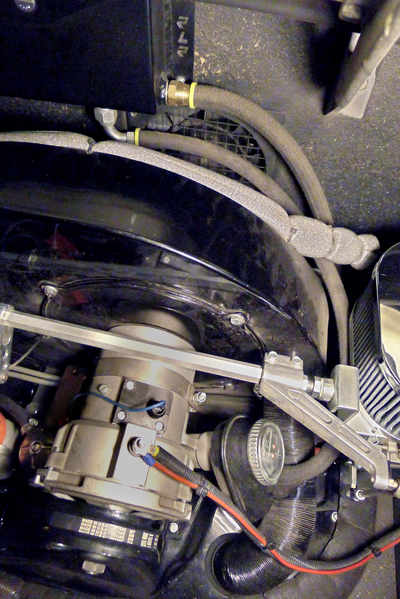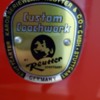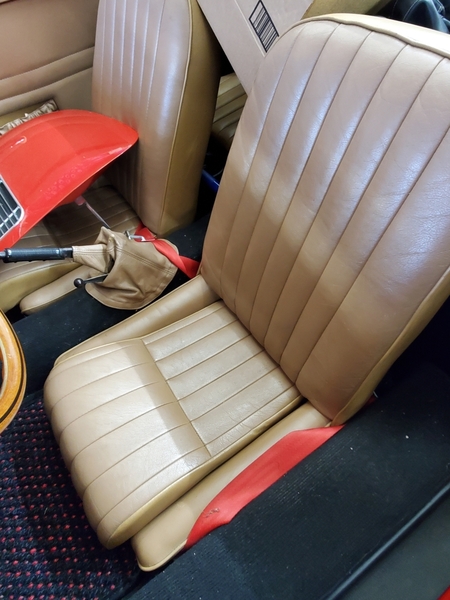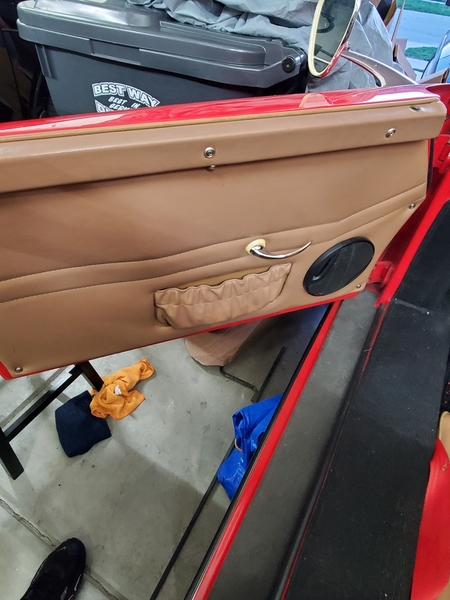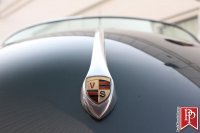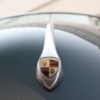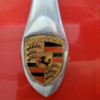Hi I'm new to owning a speedster and im currently redoing the engine bay and I was thinking of somehow increasing the volume of air the goes in the engine bay for cooling and I was wondering if anybody had any suggestions on how I can accomplish that. Thanks in advance.
Replies sorted oldest to newest
You should have a 8" opening on the fiberglass firewall at the fan intake. A 1" gap across the base of the firewall will allow a lot of air too. Be sure to place some sort of screen at the engine fan intake.
The side profile of a Speedster looks a lot like a wing so I don't subscribe to a lot of air entering through the engine lid grille, especially at highway speeds- I think you're far better off to pressurize the area in front of the firewall/over the trans with a scoop from underneath and cut a 6" hole in the firewall in front of the fan (if it's not already there). By having air flow through the engine compartment (and out the grille) radiated heat from the shroud/cylinder covers/alternator and block will be removed from the engine compartment, the engine itself (fan and carbs) will ingest air closer to ambient temps and will run within normal parameters a greater percentage of the time. Also make sure the sled tins (and little back pieces that bolt on the rear of the cylinder covers) are installed so spent cooling air can exit and enter the under the car airstream properly, the back is sealed off so no preheated air can enter the engine compartment from around the exhaust and the doghouse cooler air exit has an extension so it's not re-ingested. I think that's about it... Al
CMC/FF had builder cut out a 1/2 moon section of fiberglass on firewall (not all builders follow the build manual). VS used an 8" circular hole covered with HW screen. Both were behind the fan area. Sealing hot exhaust/heater box heat out of engine bay is important too. Folks in hot climates make a prop to hold the engine open a few inches. You can get a louvered engine deck lid too. DrClock did one body with side intake openings like the Boxster (or on the 359 replica).
You can always cut out an opening behind the rear licence plate. Not sure how much that would help, but it's a neat thing to show people...
Attachments
Thank you all for the quick replies. I will cut a hole on the firewall since it doesn't have one already, does anybody have any pics of the hole in the wall for guidance and should I put any kind of duct on it or just drill the hole and put a screen on it? I also have a prop the keeps the hood open about 4 inches too.
@Adrian R. tell us what make of Speedster you have, first. Some, like the CMC and early IM cars, had a semi-circular area right in front of the engine that gets cut out.
If you have something different, then the hole is placed right in front of the fan opening in the fan shroud.
Al and I agree regarding the shape of a Speedster in profile (that it is essentially an airfoil), and everybody knows that because of the shape of the thing, it's super-hard to get enough air to the (air-cooled) engine.
We disagree, however, regarding how to get more air into the compartment. This isn't facebook and we're actual adults, so we know how to disagree and still remain friends.
My way of looking at it is like this:
We go absolutely apoplectic when a guy leaves his tins off, because we all agree that there is a top and a bottom as it pertains to the cooling of the engines. Air comes into the fan on the top, blows through the cooler or over the heads and cylinders, and exits on the bottom. Between the two is a great wall of tin that keeps the hot side hot and the cold side cold.
I understand the arguments that air from the underside of the car up by the firewall is not the same thing as air that is discharged across the heads and cylinders, but no matter what you believe regarding airflow under the vehicle while in motion - it is the in the same cavity as the discharge of the stock doghouse air-cooler. At a minimum, pulling air from this cavity is pulling some of the reheated air from the oil cooler into the intake. Also, the argument presupposes that the vehicle has all of the sled tins (almost none of them do) and is always in motion and discharging air out the back of the car, which is not always the case. Several of the times I've come the closest to overheating have been in stop-and-go traffic.
I drank the Kool-Aid and put not one, but two giant holes in my firewall, and filled them with fans to force air into the engine compartment. The car actually runs hotter with them on than off, and hotter with the holes than before I had them.
Everybody talks about the infinite wisdom of the Sainted German Engineers (hats off, please), especially as it pertains to cooling - then advocates for the thing they most tried to avoid, which was pulling air from under the car into the engine. They pulled air from the top side. While the shape of the car is working against this effort, it's the only game in town. ANYTHING we can do to get more air into the engine compartment from the top is useful. The SGEs cut louvers in the Carrera decklid, and just added a second grill on later 356s.
Opening (or even removing) the rain tray is on my short list of useful projects. The IM/911 hole behind the plate is another method. I've seen one or two Speedster replicas with a second grill (like a 356C had). The Carrera louvers look cool, and can't hurt, but they provide very little by the way of open area.
Terry Nuckels reported that his car ran cooler with a luggage rack and a suitcase - which makes sense in that the airflow over the airfoil of the car is disrupted by the suitcase back there. Almost anybody who's driven where it's really hot will prop open the decklid by a couple of inches - I've had my oil temperatures drop 15* in the desert with this change.
It'd be nice to have some definitive, actual data, but the closest we've come it when Bruce did his manometer tests a few years ago, and they confirmed what I'm saying.
Regardless, guys (me included) are going to believe what they want to believe until there is conclusive data to prove otherwise. I'm going to continue to seal the top from the bottom.
I'm glad I didn't belong to this site years ago, when I drove - over time - two Karmann Ghias, one original VW, and two Corvairs. I know those VW engines were smaller in capacity, and didn't rev as highly, but I never once worried about 'more cooling air'.
I always figured the grills on the engine lids and the sealing tins were sufficient. Mainly, because that's the way the builders designed them, and I don't recall seeing too many air cooled cars back then over heating.
They were driven, and enjoyed, without me going to lengths to cut more holes, more openings, more grills.
I guess I was just stupid back then, and didn't realize what mistakes I was making...
With a 1600cc engine, outside of the oil cooler heating up the 3rd cylinder way too much there wasn’t a lot to worry about the engine IMO. but occasionally someone would toast one and would not know why. The Karmannghia Ghia I owned suffered more from window seal noise
I use to like fall rides when the outside temp was colder the 2110cc IM would run really nice. just saying.
Get rid of the chrome tin. Basic black, either gloss or flat is the way to go. Chrome makes it run hotter.
.
@Adrian R. , here's a pic of the firewall hole that was standard on later Vintage Speedsters (the old VS that was in Hawaiian Gardens, CA). (The black box on the firewall is an after market oil breather that we can ignore for now.)
.
VS just cut the hole in the firewall (with some screening to keep out road debris).
As an experiment in increasing cooling, I added an electric fan behind the hole to help force more air into the engine compartment. Stan tried the same thing (but, being Stan, went for two holes and two fans). He says that these did not help him one bit.
My findings were less conclusive. I think the fan does not help engine cooling one bit while under way. Once stopped though, engine off, it may help a little.
So, why would you care what happens once the engine is shut down? You probably wouldn't if you never had to start the engine again. But, you often do, and sometimes after only a brief shut down. Like when you stop to gas up, or buy a sandwich, or to pull off the road at an ocean overlook and ponder whether or not life is better on the coast than it is in flyover country.
It's pretty easy to prove to yourself that the engine compartment gets hotter after shutting down than it ever is with the engine running (with the cooling fan spinning). The engine case is still very hot, but with no air flowing through the shroud and over the heads, the heat radiates up into the engine compartment and everything (including the carbs and fuel lines) just keeps getting hotter.
I have managed to convince myself that keeping my little electric fan running at times like this (like, when stopped for gas) makes the engine easier to restart because there's less opportunity for liquid gas in the carbs to percolate and form bubbles.
Does this mean you should bother installing one of those fans? Probably not.
But then you likely don't have this thing about toggle switches that I do. I've been thinking about hooking up little red and blue lights that would flash whenever I turn the fan on with my toggle switch.
How cool would that be?
.
Attachments
Stan is on it ! The best possible way to keep it cool is ABSOLUTELY separate/isolate the top of the engine (entire engine compartment) from the bottom of the engine. It cannot be expressed enough to do this job meticulously ! Even non-used holes from previously used screws ! Once that is accomplished, we can start to make a difference in cooling by unrestricting the air flow into the engine compartment. From my own experience I know that my VS came with that hole in the firewall so that was the first thing I plugged up (with a removable one in case I was wrong) . Next was to take great pains to seal up the top half of the engine.
Next was to install a manometer tube down in the engine compartment through the grill and perform road tests taking Manometer readings under various loads and speeds. Any negative pressure reading would be telling me that I have a restricted cooling air intake system. It did, 1.5 inches (H20) to be exact. The simplest fix was to just prop the deck lid open about an inch. I then read 0 inches (H20). From here it's up to you how/what you want modify to remove this restriction. My opinion is that the Grill is not where the restriction is. Its that "scrunched-up" area on both sides (right and left) of the edge of the rain guard where the air finally enters the engine compartment. Trimming that area back a little did the trick. This is a pretty important part in keeping our little beasts healthy for a long time!
I should add that I was doing a lot of oil temp testing concurrently and obviously the data from the two told me the story and a learned a few things along the way. Bruce
Thanks sacto mitch. That helps alot. I will cut a hole and see if it makes a difference and maybe do the fan install maybe that will push air into the cooling fan. Thank you to all that replied I will post back with some results.
@Sacto Mitch posted:.
But then you likely don't have this thing about toggle switches that I do. I've been thinking about hooking up little red and blue lights that would flash whenever I turn the fan on with my toggle switch.
How cool would that be?
.
Do the red and blue lights go along with the ones behind you(with siren) in the mirror when flipping switches while distracted driving and admiring your electrical marvel?
You haven't said what manf you have. If FF/CMC then here's how they spec cutting the fire wall. There is raised area that get cut out.

Attachments
I did the cutout but didn't do the splash apron.
WOLFGANG..I don't know what manufacturer made the kit I got the car from my uncle is there a way to find out?
One factor not mentioned in this thread is engine size. A larger engine puts off more heat than a smaller engine and MAY cause some recommendations to be classified as requirements. For example, a year ago due to my extraordinary engine building prowess, I left a couple of paper towels in the engine compartment that found their way into the center of the cooling fan with predictable results. I did a lot of data tracking before I dropped the engine again and found the culprits cozied up inside the fan. I removed the paper towels and reinstalled the engine and saw normal conditions return. While I was testing, I did not replace the perimeter tin.
Those normal conditions are 180F oil temperatures under all conditions when the engine is warm. It doesn't matter if the engine tin surrounding the outside perimeter is installed or not, 180F. Remove the doghouse internal oil cooler and only use the external oil cooler and fan (replacing the doghouse tin with the older tin) and you still get 180F. Intake air temperatures are similarly stable running 140F-150F regardless.
I didn't put a hole in the firewall because I placed a big air conditioning heat exchanger there (another reason I dumped the internal oil cooler since it heats up that area). I don't have a rain shield under the grill, I did put a cutout behind the license plate, and there's a rectangular cutout on either side next to the plugs that I've never attempted to seal. Net result is that there are holes nearly everywhere.
However, my mildly massaged 1776 runs at normal temps all of the time. Granted, a hot day where I live is 92F. But, I do drive up mountains and get caught in slow traffic at times with no temperature creep. I'm thinking that my engine is small enough that it is more forgiving with regards to airflow. It certainly isn't my extraordinary design skills.
@Adrian R. posted:WOLFGANG..I don't know what manufacturer made the kit I got the car from my uncle is there a way to find out?
How long has Uncle owned/been working on it? 20-30 years FF/CMC/early IM. Assume he's not avail to question?
Cast Aluminum 1 piece engine grill? FF/CMC/early IM
Post photo's of interior - FF/CMC is very basic - flat door panel, not many seams on bucket speedster seats (tight in butt area)
Rubber vinyl covered dash pieces (3) - FF/CMC
Hood/trunk hinges have raised INTERMECANNICA cast in the - woohoo IM
Gold CLASSIC serial number - FF/CMC
Silver tape SN - IM
Hood crest says CLASSIC SPEEDSTER - CMC Says CLASSIC FIBERFAB - FF

4 chrome tipped exhaust (ANZA) - CMC
Gauges say VINTAGE - CMC
That's just a badge that was added --- per the OEM's badging. Post pictures and we'll try to id for you.
Slightly different shape but the Spyder I have sucks air through the grills when stopped or doing less than 30-35 mph or so, then hits a sort of neutral zone with air pressure inside the engine bay equal to whats above the deck, and then at about 45 or 50 starts reliably blowing air out through the grills.
This I know from taping a bunch of 2-inch lengths of yarn to the grills and the deck and training a video camera on them as I drove.
@Adrian R. posted:I asked my uncle and he didn't remember he bought it 3 yrears ago. This is one of the emblems on the car.
Photos of the dash with the gauges, engine lid hinges, and photos of the interior will help identify it.
The interior is a late 90s/early 00s Vintage Speedster.
-=theron
Yup VS - chrome dash strip/seats/door pockets/shift/brake boots/higher heater vents. Bet it has a curly red wire in engine compartment going to top of Alternator (generator). I've never seen their hood badge on a car.
Attachments
@Adrian R. posted:Well its a 1957 and I'm not sure what builder made it but this what my engine bay looks like. Don't mind the mess right now.
This one is an earlier VS; the infamous red coiled wire to the alternator is a giveaway. It is identical to my 2004 and doesn’t have a hole on the firewall. From what I’ve read here holes were cut on the firewall for 1915 cc and larger engine equipped cars, 1600s and 1776s did not. This makes sense because I ordered my car with a 1776 but Kirk delivered it with a 1915 at no extra cost because they were out of the 1776s. I would’ve preferred the 1776 but....
What I did came out of the Gene Berg book. I cut a hole on the front tin and ran a hose to a 12” x 1” fabricated aluminum scoop that I located by the right rear torsion bar tube. Not sure how it works on a Speedster but according to Gene Berg, on a regular Bug that becomes a low pressure area when the car is moving and it provides a supply of cool fresh air. I have a Gene Berg oil dipstick thermometer and after sustained highway runs at 65 mph and up and when the weather is hot the oil light will still flicker and/or light up so I’m not sure if that works at all. All I know is that when ambient temperatures are lower the oil light doesn’t flicker or comes on under the same road conditions.
First off @Adrian R. welcome to the madness!
Forgive me if I’m making assumptions, but as a newbie here, sometimes we inadvertently ask the wrong question for the right answer we’re seeking. I was a newbie only 6 months ago and I sure asked far too many of the wrong type of questions before working out what I really wanted to achieve. In this case, I’m assuming you actually want to know ‘How can I prevent my car from overheating’ ?
Although many of the suggestions above will help get more air into your engine bay, I would suggest there are things to check first before going down the path of forcing greater air induction. As @Michael Pickett says above, ‘It’s all about the oil temperature’.
1. Do you have a full flow oil system? A separate oil filter will make changing oil easier as well as offer better protection for your engine, and a separate oil cooler will probably be the best investment in keeping your oil cool.
2. Do what @DannyP says and get rid of any chromed tinware as it doesn’t shed heat quickly. He’s also a big fan of dogsled tins, so ensure they are fitted to help direct the air correctly.
3. Everyone will tell you to ensure the hot air coming from the bottom half of the engine doesn’t mix with the cool air coming in to the top half, so ensure that the engine bay tinware is a good seal.
Before you get too involved in more complicated mods, I personally would do the 3 points above and see how hot the engine runs. It may be enough, or it may not. If it is, then you’ve saved time and money. If not, then you can look at further options. All our cars here are different in many ways, even if outwardly they look similar - engine size, gearbox ratios, extra capacity oil sump, full flow oil cooling system, tyre circumference, where we live (e.g. cold England vs hot Florida) and how we drive our cars all determine the amount of cooling required. Good luck and enjoy the journey!
Small point: make sure the spark plug boot skirts are there, and spread over the holes in the tin evenly and as completely as possible. Two or three of them on my Spyder were a bit bunched up and even that made probably a 10 degree F difference in oil temperature on a hot day.
It's literally a 60-second inspection/fix.
Well I don't know if the car is running hot. When I got it the carbs were leaking fuel out every gasket. I sent the T-bodies to get rebuilt and I rebuild the carbs my self. It doesn't have an extra oil cooler and I just wanted to add more air flow into the engine compartment. Also I adjusted the valves because they were to tight so once I get it back running I will know more about the oil getting hot or not.
.
Adrian, @Martin's Eleven (UK) is right about a number of things.
The way you phrased your question had us making suggestions for good engine bay ventilation, but proper oil cooling is just as (and maybe more) important.
The stock VW engine never made much more than about 50 hp, so the stock (doghouse) oil cooler was adequate in most conditions.
But most of our engines make double that power or more (some a lot more), so external oil coolers with electric fans are common additions. These engines are also very sensitive to ambient temperature. I can pretty accurately tell what the outside air temperature is by watching my temperature gauge. Below 65 degrees, the fan on the cooler is almost never needed. But above that, it is.
An external cooler can cause problems of its own in colder weather, though. If it's plumbed permanently 'in line', the engine can take forever to get up to proper operating temperature. So, most of these are hooked up through a thermostat that routes oil back to the engine until the oil gets hot enough.
Again, it depends on how much power your engine makes, where you drive, and how you drive, but external coolers (and extended sumps, too) are often required when running high performance VW engines in the cramped engine bay of a Speedster.
.
No high performance engine here. Just a weekend cruiser.
Adrian, again, forgive me if I'm teaching you to suck eggs but if your engine is modified in any way, the valve clearances may need to be different from standard. See this comment in another post about aluminium or chromoly pushrods - stock has 0.006" gap (due to the ally expanding more with heat) whilst the chromoly pushrod has a 'loose zero' gap. From your comment that it is a weekend cruiser it sounds like it's a standard 1600?
If you're checking the whole car is mechanically sound, then it may be worth reading my story of making my Speedster reliable and safe to drive over the last six months, and you'll see many points where I messed up or learnt something new - it was written as a newbie and hopefully it will have useful pointers that can help you. Mine is not the only story here - there is a huge wealth of knowledge and info that can be found via the search box.
These cars are remarkably easy to work on, and mercifully simple in engineering terms, and there's nothing like having the peace of mind that knowing your car inside out brings when you drive it - you can enjoy the drive rather than having a niggling worry that something will go wrong. And you'll have made the car far more reliable from the get go.
Keep posting pics and updates and let us know how you're getting on!
Pop a valve cover and use the magnet test. Just make sure to test the pushrod itself and not the rounded end: they are all steel.
Then you'll know for sure what your clearance should be Clarence!
On another note. I'm not sure I'd I have to go to another thread but I want to take the aftermarket radio that came with the car out but I still want to listen to music. Has anybody installed a Bluetooth receiver in their speedster? Something that can be hidden so I can just use my phone with?
@Adrian R. posted:On another note. I'm not sure I'd I have to go to another thread but I want to take the aftermarket radio that came with the car out but I still want to listen to music. Has anybody installed a Bluetooth receiver in their speedster? Something that can be hidden so I can just use my phone with?
I think @Joe Fortino had this done.



